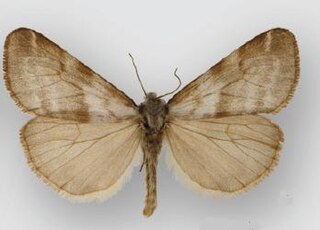
Caeneressa is a genus of moths in the family Erebidae.

Dodia is a genus of woolly bear moths in the family Erebidae. The genus was erected by Harrison Gray Dyar Jr. in 1901. The moths are found in subarctic tundra and taiga ecosystems. They belong to the subtribe Callimorphina of tribe Arctiini.

Loxophlebia is a genus of moths in the subfamily Arctiinae. The genus was erected by Arthur Gardiner Butler in 1876.

Caeneressa diaphana is a moth in the family Erebidae first described by Vincenz Kollar in 1844. It is found from India to southern China, Taiwan and Sundaland.
Dodia diaphana is a moth of the family Erebidae. It was described by Eduard Friedrich Eversmann in 1848. It is found in Russia and Mongolia.
Leucanopsis rhomboidea is a moth of the family Erebidae. It was described by Sepp in 1848. It is found in Mexico, Guatemala, Panama, Ecuador, Bolivia, Peru, Suriname and Brazil.
Loxophlebia aurantiaca is a moth of the subfamily Arctiinae. It was described by E. Dukinfield Jones in 1908. It is found in south-eastern Brazil.
Loxophlebia broteas is a moth of the subfamily Arctiinae. It was described by William Schaus in 1892. It is found in Santa Catarina, Brazil.
Loxophlebia crocata is a moth of the subfamily Arctiinae. It was described by Gottlieb August Wilhelm Herrich-Schäffer in 1854. It is found in French Guiana and Rio de Janeiro, Brazil.
Loxophlebia davisi is a moth of the subfamily Arctiinae. It was described by A. E. Gibbs in 1913. It is found in Honduras.
Loxophlebia ducallis is a moth of the subfamily Arctiinae. It was described by Peter Jörgensen in 1935. It is found in Paraguay.
Loxophlebia eumonides is a moth of the subfamily Arctiinae. It was described by Herbert Druce in 1883. It is found in Ecuador.
Loxophlebia flavinigra is a moth of the subfamily Arctiinae. It was described by E. Dukinfield Jones in 1908. It is found in Paraná, Brazil.
Loxophlebia imitata is a moth of the subfamily Arctiinae. It was described by Herbert Druce in 1884. It is found in Guatemala, Panama and Venezuela.
Loxophlebia masa is a moth of the subfamily Arctiinae. It was described by Herbert Druce in 1889. It is found in Mexico and Honduras.
Loxophlebia picta is a moth of the subfamily Arctiinae. It was described by Francis Walker in 1854. It is found in the Amazon region.
Loxophlebia postflavia is a moth of the subfamily Arctiinae. It was described by Herbert Druce in 1898. It is found in French Guiana.
Loxophlebia splendens is a moth of the subfamily Arctiinae. It was described by Heinrich Benno Möschler in 1872. It is found in French Guiana.
The Euchromiina are a subtribe of tiger moths in the family Erebidae. It was described by Arthur Gardiner Butler in 1876. Many species in the subtribe are mimics of wasps.
Glyphodes convolvulalis is a moth in the family Crambidae. It was described by Sepp in 1848. It is found in Surinam.



